Highly qualified team
Researchers
The Center for Bioinformatics and Molecular Simulation (CBSM) at the University of Talca is home to a highly qualified team of researchers who make significant contributions to the advancement of science and technology. Below is a brief introduction to each of them:
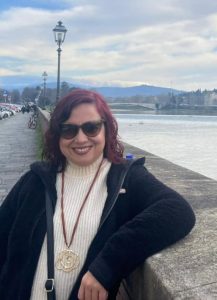
Wendy González studied Biology at the University of Havana, Cuba (1998–2003). During the last two years of her undergraduate studies, Wendy trained as a specialist in Bioinformatics at the Center for Genetic Engineering and Biotechnology (CIGB) in Havana, Cuba.
In 2004, Wendy moved to Chile and worked as a research assistant at the Center for Scientific Studies in Valdivia (CECs), where she discovered her scientific passion: ion channels, in the group led by Ramón Latorre. She later pursued doctoral studies (2005–2010) in the group of Prof. Danilo González, studying potassium channels in plants from a structural perspective at the Universidad de Talca. Her Ph.D. was funded by the National Council of Sciences (CONICYT).
Afterward, she won her first grant (Fondecyt de Iniciación) to study K2P channels in plants and animals. At the same time, she received specialized training in plant biophysics as a postdoctoral researcher in the laboratory of Prof. Ingo Dreyer at the University of Potsdam, Germany.
In 2012, she became director of the Center for Bioinformatics, Simulations and Modelling at the Universidad de Talca. In 2014, she received her second grant (Fondecyt Regular*) and was appointed Associate Professor at the Universidad de Talca. In 2017, Wendy joined the Millennium Nucleus of Ion Channels-Associated Diseases (MiNICAD, 2017–2023) as main researcher. She later received a second Fondecyt Regular grant**, became a Full Professor in 2021, and is currently leading a third Fondecyt Regular project entitled:
“Ligand and Structure-Based Polypharmacology of K+ Channels from the Primary Sensory Neurons.”
Research Projects & Funding
Previous grants:
Fondecyt Regular
Understanding the structural mechanism of selective blockers of pH-gated K2P channels
(2014–2019, with pre- and postnatal leave)
Fondecyt Regular
Structural insights into the mechanism of multi-channel blockers of atrial ion channels
(2019–2023)
 Jans Alzate-Morales performed his undergraduate studies, in Pharmaceutical Chemistry, at the University of Antioquia, Colombia (1995-2001). Afterward, his doctoral studies in chemistry were conducted at the University of Chile, Chile (2002-2006), funded by a fellowship from the German Government granted through DAAD (Deutscher Akademischer Austausch Dienst).
Jans Alzate-Morales performed his undergraduate studies, in Pharmaceutical Chemistry, at the University of Antioquia, Colombia (1995-2001). Afterward, his doctoral studies in chemistry were conducted at the University of Chile, Chile (2002-2006), funded by a fellowship from the German Government granted through DAAD (Deutscher Akademischer Austausch Dienst).
The topic of his thesis was focused on the computational study of protein-ligand interactions in the CDK2/Cyclin system, which is directly related to cancer disease. During his Ph.D., he spent six months doing research in the group “Efectos del Medio”, Faculty of Physical Chemistry of the University of Valencia (Spain) and in the Department of Theory of Fritz Haber Institute of the Max Planck Society, Berlin (Germany ).
In 2007, he was inserted in the Center for Bioinformatics and Molecular Simulation (CBSM), to continue his postdoctoral studies with a scholarship for Academy Insertion granted by the Chilean Government through PBCT (Bicentennial Program of Science and Technology). In 2010 he was hired as a lecturer and in 2012 obtained a permanent position as Assistant Professor attached to CBSM, Faculty of Engineering, University of Talca.
Research lines
The main area of his research is focused on understanding the subtle phenomena that occur at the molecular level in the interaction protein-drug, protein-substrate recognition, and enzymatic catalysis. To do so, he uses several computational tools such as molecular docking, molecular dynamics, quantum chemistry methods and hybrid QM / MM, among others.
Research funding
- “Biotransformation Processes Catalyzed by Ligninolytic Enzymes from Phanerochaete chrysosporium: Rational Protein Design from Computational calculations and site-directed mutagenesis studies.”, FONDECYT Regular Project, 4 years, 2014, Principal Researcher.
- “Understanding the Protein-Ligand Binding Phenomena through hybrid calculation approaches and other Computational Methods”, Proyecto FONDECYT Iniciación, 3 years, 2010, Principal Researcher.
- “Fishing For Complements: Design Of Compounds That Simultaneously Interact With Monoaminergic Proteins And Nicotinic Receptors, Based On Similarities Between Their Ligand Binding Sites”, Proyecto FONDECYT Regular, 4 years, 2013, Associate Researcher.
- “Insights Into The Structural Basis Of The Interactions Between Camp-Dependent Protein Kinase (PKA) And Its Substrates: Development Of Predictive Molecular Models And Testing In The Study Of The Interactions Between PKA And Potassium Channel Akt2”, Proyecto FONDECYT Regular, 3 years, 2013, Associate Researcher.
- “Simulaciones Moleculares de Catalizadores Biológicos. Nuevas Metodologías para el Cálculo de Potenciales de Fuerza Media y Aplicaciones de Interés Biomédico”, Ministerio de Economía y Competitividad, Gobierno de España, 4 years, 2013, Associate Researcher.
- “Concurso de Apoyo a la Formación de Redes Internacionales entre Centros de Investigación”, Proyecto CONICYT, 2 years, 2013, Associate Researcher.
- PI FONDECYT Regular No. 1181253, “Estimating residence time in protein-ligand complexes: New computational protocols for understanding binding kinetics of drugs.”
- Sponsoring Researcher, FONDECYT Postdoctoral No. 3180321, “EVALUATION OF THE MOLECULAR STABILITY OF CYLINDRIN-LIKE STRUCTURES VIA MICROSECOND MOLECULAR DYNAMICS SIMULATIONS”.
- Co-researcher, FONDECYT Regular No. 1150615 “DESIGNING CHEMICAL POLY-BULLETS FOR NICOTINIC ACETYLCHOLINE RECEPTORS AND MONOAMINE TRANSPORTERS (SERT, NET AND DAT). A POLY-PHARMACOLOGY APPROACH TO UNDERSTAND THE NICOTINE ADDICTION AND WITHDRAWAL SYNDROME MEDIATED BY MULTIPLE RECEPT”.
- Co-researcher, FONDECYT Regular No. 1170662 “Multisteric drugs: Design of polypharmacological agents that simultaneously interact with monoaminergic proteins and nicotinic receptors, based on similarities between their multiple binding sites”.
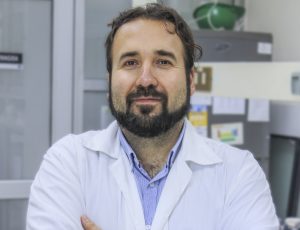
Mauricio Arenas
Research Lines:
- Development and characterization of proteins with biotechnological interest.
- Structural bioinformatics and protein data mining.
- Development of databases and bioinformatics tools.
Publications
Argandoña, Y., Olivos, A., Obando, P., Imas, F., Pohl, E., Quatrini, R., & Arenas-Salinas, M. (2025). Novel metal sites revealed by spectroscopic and structural characterization of the ferric uptake regulator from Acidithiobacillus ferrooxidans. Computational and Structural Biotechnology Journal, 27(November 2024), 765–777. https://doi.org/10.1016/j.csbj.2025.02.017
Contreras, F., Rivero, K., Rivas-Pardo, J. A., Liendo, F., Segura, R., Neira, N., Arenas-Salinas, M., Cortez-San Martín, M., & Arenas, F. (2025). Biosynthesis of Gold Nanostructures and Their Virucidal Activity Against Influenza A Virus. International Journal of Molecular Sciences, 26(5), 1934. https://doi.org/10.3390/ijms26051934
Fernández-Yáñez, V., Suazo, P., Hormazábal, C., Ibaceta, V., Arenas-Salinas, M., Vidal, R. M., Silva-Ojeda, F., Arellano, C., Muñoz, I., & Del Canto, F. (2024). Distribution of papA and papG Variants among Escherichia coli Genotypes: Association with Major Extraintestinal Pathogenic Lineages. International Journal of Molecular Sciences, 25(12), 6657. https://doi.org/10.3390/ijms25126657
Angles, R., Arenas-Salinas, M., García, R., & Ingram, B. (2024). An optimized relational database for querying structural patterns in proteins. Database, 2024(00), 1–15. https://doi.org/10.1093/database/baad093
Research Funding
Developing the foundations and applications of path manipulation operations. Fondecyt Regular (1221727) Director: Renzo Angles. Universidad de Talca. (2022-2026).Co-investigador
Surface-exposed domains of pili ushers as binding sites for antibodies and proinflammatory cytokines: Impact on pili assembly, adherence and virulence of pathogenic Escherichia coli. Fondecyt Regular (1200979) Director: Felipe del Canto (U.Chile. Facultad de Medicina). (2020-2024). Co-investigador.
Identification and characterization of the regulatory iron binding site from the Acidithiobacillus ferrooxidans transcription factor. Fondecyt de Iniciación No. 11180665. Director. (2018-2022)
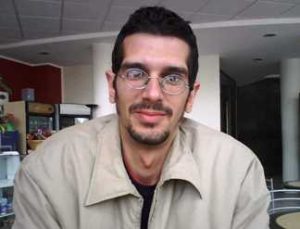
Julio Caballero
Studied B.Sc. in Chemistry at Universidad de La Habana, Cuba (1996-2001). His Ph.D. stay was at Universidad de Talca, Chile, and was devoted to the study of differential potency of ATP-competitive protein kinase inhibitors using a group of molecular modeling methods. He got a permanent position at Universidad de Talca in 2012. At this moment, he is an assistant professor at CBSM, Faculty of Engineering, Universidad de Talca, and he is the author of more than 70 papers and one book chapter in the research area. His research team consists of one postdoctoral researcher, two Ph.D. students, and two diploma students. His main research focuses on the study of biomolecular systems by using computational chemistry, bioinformatic tools, and molecular modeling.
Research lines
- Enzyme catalysis using QM/MM methods.
- Development of tools for analyzing molecular docking results.
- Protein-ligand interactions using protocols including docking, molecular dynamics (MD), QSAR, de novo design, virtual screening.
- Ligand-based molecular modeling (QSAR, pharmacophore modeling, chemoinformatics). Applications to the study of the potency of synthetic bioactive compounds and natural products.
- Modeling of enzyme–ligand systems such as protein kinase inhibitors, angiotensin converting enzyme inhibitors, acetylcholinesterase inhibitors, etc.
- Structural features of target proteins, such as potassium channels, the sigma1 receptor, the TRPV-1 channel, etc.
- Methods of computational biochemistry, pharmaceutical modeling, protein structure and function, enzyme reactivity and selectivity, and contributions to medicinal chemistry topics.
Research funding
FONDECYT Regular # 1250367 ‘Computational approaches to understanding tyrosinase and catechol oxidase catalysis and interactions with inhibitors.’ 2025-2029, (Main researcher)
Publications (2020-2024)
163. C. Barrales-Martínez*, R. Durán*, J. Caballero. Shannon Entropy variation as a global indicator of electron density contraction at interatomic regions in chemical reactions. J. Mol. Model. 2024, 30, 371 (ISIIF2023: 2.1)
162. N. Flores, L. Rivillas-Acevedo, J. Caballero, F. Melo, L. Caballero, C. Areche, D. Fuentealba, F. Aguilar, A. Cornejo*. Rosmarinic acid turned α-syn oligomers into non-toxic species preserving microtubules in Raw 264.7 cells. Bioorg. Chem. 2024, 151, 107669 (ISIIF2023: 4.5)
161. J.L. Velázquez–Libera*, J. Caballero*, J. Alzate-Morales, J.J. Ruiz-Pernía, I. Tuñón*. Understanding the interactions of Ubiquitin Specific Protease 7 (USP7) with its substrates through MD simulations: insights into the role of its C-terminal domains in substrate recognition. J. Chem. Inf. Model. 2024, 64, 4134-4148 (ISIIF2023: 5.6)
160. C. Barrales-Martínez*, C. Illanes-Solis, R. Durán, J. Caballero. Exploring the electronic and steric effects on the dimerization of intramolecular Frustrated Lewis Pairs: A comparison between aminoboranes and aminoalanes. Dalton Trans. 2024, 53, 7000-7011 (ISIIF2023: 3.5)
159. D. Méndez, F. Tellería, M. Monroy-Cárdenas, H. Montecino-Garrido, S. Mansilla, L. Castro, A. Trostchansky, F. Muñoz-Córdova, V. Zickermann, J. Schiller, S. Alfaro, J. Caballero, R. Araya-Maturana*, E. Fuentes*. Linking triphenylphosphonium cation to a bicyclic hydroquinone improves their antiplatelet effect via the regulation of mitochondrial function. Redox Biol. 2024, 72, 103142 (ISIIF2023: 10.7)
158. J.L. Valdes-Albuernes, E. Díaz-Pico, S. Alfaro, J. Caballero*. Modeling of noncovalent inhibitors of the papain-like protease (PLpro) from SARS-CoV-2 considering the protein flexibility by using molecular dynamics and cross-docking. Front. Mol. Biosci. 2024, 11, 1374364 (ISIIF2023: 3.9)
157. H. Montecino-Garrido, M. Sepúlveda, D. Méndez, M. Monroy-Cárdenas, S. Alfaro, M. González-Avendaño, J. Caballero, F.A. Urra, R. Araya-Maturana*, E. Fuentes*. Assessing mitochondria-targeted acyl hydroquinones on the mitochondrial platelet function and cytotoxic activity: role of the linker length. Free Radic. Biol. Med. 2023, 208, 26-36 (ISIIF2023: 7.1)
156. R. González, J. Murillo-López, W. Rabanal-León, L. Prent-Peñaloza, O. Concepción, P. Olivares, Y. Duarte, A.F. de la Torre, M. Gutiérrez*, J. Caballero*. Multicomponent synthesis and photophysical study of novel α,β-unsaturated carbonyl depsipeptides and peptoids. Front. Chem. 2023, 11, 1245941 (ISIIF2023: 3.8)
155. J.L. Velázquez–Libera*, J. Caballero*, J. Alzate-Morales, J.J. Ruiz-Pernía, I. Tuñón*. Insights into the structural and energetic descriptions of Ubiquitin Specific Protease 7 (USP7) catalytic mechanisms by hybrid QM/MM simulations. ChemCatChem 2023, 15, e202300344 (ISIIF2023: 3.8) [COVER]
154. L. Castillo-Campos, J.L. Velázquez–Libera, J. Caballero*. Computational study of the binding orientation and affinity of noncovalent inhibitors of the papain-like protease (PLpro) from SARS-CoV-1 considering the protein flexibility by using molecular dynamics and cross-docking. Front. Mol. Biosci. 2023, 10, 1215499 (ISIIF2023: 3.9)
153. S. Monroy-Moya, J. Caballero, F. González-Norambuena, M. Simirgiotis, E. Sánchez, C. Areche, D. Fuentealba, A. Cornejo*. The key features of catechols and α,β unsaturated carbonyl moieties: interaction with α-syn hydrophobic peptide and activation of catecholamines pathway in cells. ChemistrySelect 2023, 8, e202301106 (ISIIF2023: 1.9)
152. R. González-Alemán*, D. Platero-Rochart, A. Rodríguez-Serradet, E.W. Hernández-Rodríguez, J. Caballero, F. Leclerc*, L. Montero-Cabrera. MDSCAN: RMSD-based HDBSCAN clustering of long molecular dynamics. Bioinformatics 2022, 38, 5191-5198 (ISIIF2022: 5.8)
151. I. Monte*, J. Caballero, A.M. Zamarreño, G. Fernández-Barbero, J.M. García-Mina, R. Solano*. JAZ is essential for ligand specificity of the COI1/JAZ co-receptor. Proc. Natl. Acad. Sci. U.S.A. 2022, 119, e2212155119 (ISIIF2022: 11.1)
150. J. Caballero*. A new era for the design of TRPV1 antagonists and agonists with the use of structural information and molecular docking of capsaicin-like compounds. J. Enzyme Inhib. Med. Chem. 2022, 37, 2169-2178 (ISIIF2022: 5.6)
149. D. Platero-Rochart*, R. González-Alemán*, E.W. Hernández-Rodríguez, F. Leclerc, J. Caballero, L. Montero-Cabrera. RCDPeaks: Memory-efficient density peaks clustering of long molecular dynamics. Bioinformatics 2022, 38, 1863-1869 (ISIIF2022: 5.8)
148. R. González-Alemán*, D. Platero-Rochart, D. Hernández-Castillo, E.W. Hernández-Rodríguez, J. Caballero, F. Leclerc, L. Montero-Cabrera. BitQT: A graph-based approach to the Quality Threshold clustering of molecular dynamics. Bioinformatics 2022, 38, 73-79 (ISIIF2022: 5.8)
147. G. Rossino, M. Rui, P. Linciano, D. Rossi, M. Boiocchi, M. Peviani, E. Poggio, D. Curti, D. Schepmann, B. Wünsch, M. González-Avendaño, A. Vergara-Jaque, J. Caballero*, S. Collina*. Bitopic Sigma 1 Receptor modulators to shed a light on molecular mechanisms underpinning ligand binding and receptor oligomerization. J. Med. Chem. 2021, 64, 14997-15016 (ISIIF2021: 8.039)
146. J. Caballero*. The latest automated docking technologies for novel drug discovery. Expert Opin. Drug Discov. 2021, 16, 625-645 (ISIIF2021: 7.050)
145. F. Adasme-Carreño*, J. Caballero, J. Ireta. PSIQUE: Protein Secondary Structure Identification on the basis of Quaternions and Electronic Structure Calculations. J. Chem. Inf. Model. 2021, 61, 1789-1800 (ISIIF2021: 6.162)
144. J. Caballero*. Computational modeling to explain why 5,5-diarylpentadienamides are
TRPV1 antagonists. Molecules 2021, 26, 1765 (ISIIF2021: 4.927)
143. A. Cornejo*, J. Caballero, M. Simirgiotis, V. Torres, L. Sánchez, N. Díaz, M. Guimaraes, M. Hernández, C. Areche, S. Alfaro, L. Caballero, F. Melo. Dammarane triterpenes targeting α-synuclein: biological activity and evaluation of binding sites by molecular docking. J. Enzyme Inhib. Med. Chem. 2021, 36, 154-162 (ISIIF2021: 5.756)
142. F. Klein, D. Caceres-Rojas, M. Carrasco, J.C. Tapia, J. Caballero, J. Alzate-Morales, S. Pantano*. Coarse-Grained parameters for divalent cations within the SIRAH force field. J. Chem. Inf. Model. 2020, 60, 3935-3943 (ISIIF2020: 4.956)
141. E.W. Hernández-Rodríguez*, A.M. Escorcia, M.W. van der Kamp, A.L. Montero-Alejo, J. Caballero. Multi-scale simulation reveals that an amino acid substitution increases photosensitizing reaction inputs in rhodopsins. J. Comput. Chem. 2020, 41, 2278-2295 (ISIIF2020: 3.376)
140. J.L. Velázquez–Libera, J. Caballero*, I. Tuñón*, E.W. Hernández-Rodríguez*, J.J. Ruiz-Pernía. On the nature of the enzyme-substrate complex and the reaction mechanism in human arginase I. A combined molecular dynamics and QM/MM study. ACS Catal. 2020, 10, 8321-8333 (ISIIF2020: 13.084) [COVER]
139. S. Alfaro, C. Navarro-Retamal, J. Caballero*. Transforming non-selective angiotensin-converting enzymes inhibitors in C- and N-domain selective inhibitors by using computational tools. Mini-Rev. Med. Chem. 2020, 20, 1436-1446 (ISIIF2020: 3.862)
138. J.L. Velázquez–Libera, F. Durán-Verdugo, A. Valdés-Jiménez, G. Núñez-Vivanco*, J. Caballero*. LigRMSD: A web server for automatic structure matching and RMSD calculations among identical and similar compounds in protein-ligand docking. Bioinformatics 2020, 36, 2912-2914 (ISIIF2020: 6.937)
137. F. Salgado, M. Silva, J. Caballero, R. Vargas, A. Cornejo, C. Areche*. Continental and Antarctic lichens: Isolation, identification and molecular modeling of the depside tenuiorin from the Antarctic lichen Umbilicaria antarctica as tau protein inhibitor. Nat. Prod. Res. 2020, 34, 646-650 (ISIIF2020: 2.861)
136. G. Rossino, I. Orellana, J. Caballero, D. Schepmann, B. Wünsch, M. Rui, D. Rossi, M. González-Avendaño, S. Collina*, A. Vergara-Jaque*. New insights into the opening of the occluded ligand-binding pocket of Sigma1 receptor: binding of a novel bivalent RC-33 derivative. J. Chem. Inf. Model. 2020, 60, 756-765 (ISIIF2020: 4.956)
135. R. González-Alemán*, D. Hernández-Castillo, J. Caballero*, L. Montero-Cabrera. Quality threshold clustering of molecular dynamics: a word of caution. J. Chem. Inf. Model. 2020, 60, 467-472 (ISIIF2020: 4.956) [COVER]
134. R. González-Alemán*, D. Hernández-Castillo, A. Rodríguez-Serradet, J. Caballero, E.W. Hernández-Rodríguez, L. Montero-Cabrera. BitClust: fast geometrical clustering of long molecular dynamics simulations. J. Chem. Inf. Model. 2020, 60, 444-448 (ISIIF2020: 4.956)
133. J. Caballero*. Considerations for docking of selective angiotensin-converting enzyme inhibitors. Molecules 2020, 25, 295 (ISIIF2020: 4.411)
132. P. Santos, F. Lopez-Vallejo*, D. Ramírez, J. Caballero, D.M. Espinosa, R. Hernández-Pando, C.Y. Soto. Identification of Mycobacterium tuberculosis CtpF as a target for designing new antituberculous compounds. Bioorg. Med. Chem. 2020, 28, 115256 (ISIIF2020: 3.641)

Ingo Dreyer
studied Physics at the University of Hannover, Germany (1989-1995) and continued with doctoral studies (1995-1998) in the group of Prof. Rainer Hedrich in Biophysics and Plant Physiology at the University of Würzburg, Germany, funded by a PhD-fellowship of the German Science Foundation (DFG). Afterward, he moved with a European Marie-Curie Individual Fellowship to Montpellier, France, (1998-2001) and got expert training in plant molecular biology in the laboratory of Profs. Hervé Sentenac and Jean-Baptiste Thibaud. In 2001 he became a member of the group of Prof. Bernd Mueller-Roeber at the University of Potsdam, Germany, at the level of an Assistant Professor (2001-2007). In 2006 he received his Habilitation in Biophysics and Molecular Plant Physiology and was awarded a Heisenberg-Fellowship of the DFG (2007-2011). In 2010 the Alexander von Humboldt Foundation and CONICYT-Chile awarded him the Abate Juan Ignacio Molina prize of excellence, which allowed him to spend 4 months as a guest professor at the University of Talca, Chile (11/2010-02/2011). In May 2011, he moved as a professor to the Centro de Biotecnología y Genómica de Plantas (CBGP) in Madrid, Spain and received in 2011 a Marie Curie Career Integration Grant of the European Union. In 2015, he moved to the University of Talca and became Professor Titular. In 2017 he became a “Mercator Fellow” awarded by the DFG (German Research Foundation) and affiliated with the SFB 1208 at the Heinrich Heine Universität Düsseldorf, Germany, due to important contributions in bioinformatics and computational cell biology.
During his career, Ingo has spent several additional short-term research-stays in Japan, Italy, France, and Colombia.
Research lines
Ingo’s research centers on transport processes across cell membranes. The investigation of these processes helps to get deeper insights into plant nutrition and electrical signaling in plants, animals and bacteria, for instance. He combines experimental and theoretical techniques to get a more complete picture of the investigated phenomena. The experimental techniques are a broad spectrum in molecular biology, electrophysiology, and biochemistry, while the theoretical techniques comprise computational and mathematical modeling and simulation methods.
Recent Publications

Horacio Poblete
Theoretical and Computational Biophysics
Research Interests: The use of computational tools to study the structure-function relationships between biomolecules and nanoparticles; it as an efficient strategy to develop novel biomaterials to treating biological tissue repairing and/or targeting drug delivery. Biophysics, ion channels, trans-membrane transporting.
Overview
Horacio Poblete is an Associate Professor at Universidad de Talca (Chile) and director of the Ph.D. program “Doctorado en Ciencias mención Modelado de Sistemas Químicos y Biológicos” since 2023. He earned his Ph.D. in Applied Sciences from the same institution in 2013. He completed postdoctoral training in the U.S., first in the Theoretical Molecular Biophysics group at the National Institutes of Health (NIH) with Dr. José Faraldo-Gómez, and later in Dr. Jeffrey Comer’s group at the Nanotechnology Innovation Center of Kansas State University. There, he focused on biomolecule–nanoparticle interactions and the thermodynamic and structural principles underlying adsorption.
In 2017, he returned to Universidad de Talca and established the Bio-nanomaterials Group, where his research focuses on the computational design of nanomaterials for biomedical applications, particularly in protein adsorption and functionalization strategies.
He has published 42 peer-reviewed articles and has led several Fondecyt Regular projects as Principal Investigator:
- 2025-2029 (No. 1251288): “Computational Engineering of Lipid-Membrane-Mimicking Nanoparticles with Dual-Peptide Functionalization for Targeted Internalization in Cancer Cells.”
- 2021-2025 (No. 1211143): “Computational Nanotechnology: Rational Design of Peptide-Based Functional Biomaterials to Enhance Molecular Recognition.”
- 2017-2021 (No. 1171155): “New Insights into Conformational Equilibria of Proteins Adsorbed to Nanometal Surfaces Using Molecular Dynamics Simulations: Structural Effects and Protein Camouflage Applicable to Nanomedicine.”
Publications:
https://scholar.google.com/citations?user=feuxRSEAAAAJ&hl=es&oi=ao
Projects with Dr. Poblete as Co-Investigator
- Fondecyt Regular 2023, No 1231468, Rol: Co-Investigator, PI: Alexis Aspee “Evaluation of conformational dynamic aspects on the oxidation of antimicrobial-inspired peptides in phospholipid membranes by fast photoinduced free radical generation.” Universidad de Talca – Universidad de Santiago de Chile. 2023 – 2026
- Fondecyt Regular 2021, No 1211366, Rol: Co-Investigator, PI: David Naranjo “Identi- fication of a transition state in a first order protein-protein dissociation pathway.” Universidad de Talca – Universidad de Valparaiso. 2021 – 2025
- Fondecyt Postdoctoral 2020, No 3200252, Rol: Advisor. PI: Dr. Matias Zun ̃iga- Bustos ”Computer-assisted design of nanomaterials for biomedical applications: A powerful combination of silver nanoparticles and functional peptides.” Universidad de Talca. 2020-2023
- Fondecyt Regular 2019, No. 1190881, Rol: Co-Investigator, PI: Alexis Aspee ”Electron transfer processes in peptides induced by free radicals: Influence of the amino acid sequence, peptide conformation and microenvironmen.” Universidad de Talca – Universidad de Santiago de Chile 2019 – 2022
- Millennium Nuleous 2017, Rol: Associated Investigator “Millennium Nucleus of Ion Channels-Associated Diseases (MiNICAD).” Universidad de Talca. 2020 – 2023.
- Fondecyt Regular 2018, No. 1181253, Rol Co-Investigator, PI: Jans Alzate-Morales “Es- timating residence time in protein-ligand complexes: New computational tools for understanding the in-vivo pharmacological effects of drugs.” Universidad de Talca. 2018 – 2021
- Talca University Research support, Rol: Principal Investigator “Nucleo Cientifico Mul- tidiciplinario” 2017-2020 • NVIDIA GPU Grant Program 2018, Rol: Principal Investigator, “GPUs to speed-up on nanosurface simulations.”, Donation of (1) Tita Xp GPU grap hic card (USD 1200) Universidad de Talca. 2018
- Fondecyt Postdoctoral 2013, No 3140288, Rol: Principal Investigator. “Estudio de los determinantes estructurales que controla el funcionamient o de la bomba Na+/K+“ Universidad de Talca & NHLBI at NIH.

Jose Antonio Reyes
Dr. José Antonio Reyes-Suárez holds a Ph.D. in Computing Science from the University of Glasgow, UK. He currently leads the Data Science Lab at CBSM, where his research centers on the development of Artificial Intelligence (AI) and Machine Learning (ML) applications in bioinformatics and smart agriculture.
He is also the founder and leader of Thinkagro, an initiative focused on promoting the digital transformation of the agro-industrial sector in Chile.
Research Areas
- Digital transformation of agroindustry sector.
- Prediction of molecular interactions based on structural and physicochemical features.
- Modeling extreme weather events affecting agricultural systems.
- Predictive models for plant diseases and stress based on climatic and phenological data.
- Yield and quality forecasting for fruit crops using environmental and phenological indicators.
Research Projects & Funding
- Red Thinkagro (2021–2027): Technological Extension Center for the Digitalization and Automation of Agro-Industrial Enterprises (CORFO, FPYME Maule – RFS Maule-Ñuble). thinkagro.cl
- Thinkagro Center (2018–2020): Center for Technological Extension in Smart Industries – CORFO-funded. thinkagro.cl
- Early Warning System for Frost Episodes (2017–2019): Enhancing agricultural competitiveness in the Maule Region – Funded by the Maule Regional Government.
- Early Prediction of Bull’s Eye Rot in Cripps Pink Apples (2017–2019): FONDEF-funded.
- Early Frost Warning System (2015–2016): Funded by FIA.
- Apiculture Mapping in the Maule Region (2013–2015): Funded by the Maule Regional Government.
Publications
- Niño Medina, J. S., Suarez Barón, M. J., & Reyes Suarez, J. A. (2024). Application of Deep Learning for the Analysis of the Spatiotemporal Prediction of Monthly Total Precipitation in the Boyacá Department, Colombia. Hydrology, 11(8), 127. https://doi.org/10.3390/hydrology11080127.
- Muñoz, J. L., Reyes-Suárez, J. A., Besoain, F., & Arenas-Salinas, M. (2024). Prediction of DNA-binding sites in transcription factors in Fur-like proteins using machine learning and molecular descriptors. Current Bioinformatics, 19(4), 398–407. https://doi.org/10.2174/0115748936264122231016094702
- Stappung, Y., Aliaga, C., Cartes, J., Jego, L., Reyes-Suárez, J. A., Barriga, N. A., & Besoain, F. (2023). Developing 360° Virtual Tours for Promoting Tourism in Natural Parks in Chile. Sustainability, 15(22), 16043. https://doi.org/10.3390/su152216043.
- Palacios C., Reyes J.A., Knowledge Discovery for Higher Education Student Retention Based on Data Mining: Machine Learning Algorithms and Case Study in Chile. Entropy 23, 4 (485) 2021.
- Lolas M., Reyes J. A., Bull’s eye rot development in storage is related to the timing of apple fruit infection by Neofabraea vagabunda in the orchard in Chile. Acta Hortic. 1325, 73-76. 2021.
- Renzo Angles, Mauricio Arenas, Roberto García, José Antonio Reyes-Suarez and Ehmke Pohl . GSP4PDB: A web tool to visualize, search and explore protein-ligand structural patterns. BMC Bioinformatics 2019.
- Patricia Möller-Acuña, Roberto Ahumada-García and José Reyes-Suárez. Machine Learning for Prediction of Frost Episodes in the Maule Region of Chile. UCAmI 2017, LNCS 10586, 2017.
- Roberto Ahumada-García, Patricia Möller-Acuña and José Antonio Reyes-Suárez. An expert system for handling Phytosanitary Products in Chilean export fruit. IEEE Explorer, octubre 2017.
- Patricia Möller-Acuña, Alejandro Valdés-Jiménez, Roberto Ahumada-García and José Antonio Reyes-Suárez. An information system for preventive alerting of frost episodes in the Central Region of Chile. IEEE Explorer, octubre 2017.
- Patricia Möller-Acuña, Roberto Ahumada-García and José Antonio Reyes-Suárez. An information System for online Quality Control of Export Fruits. IEEE Explorer, octubre 2017.
- Yetzabel González, Roberto Ahumada-García, Patricia Möller-Acuña and José Antonio Reyes-Suárez. A system for online quality analysis for cherry harvest process inside the orchard. IEEE Explorer, octubre 2017.
- Valdebenito-Maturana, J, Antonio Reyes-Suarez, J. Henríquez, D. S. Holmes, R. Quatrini, E. Pohl, M. Arenas-Salinas. “Mutantelec: An In Silico mutation simulation platform for comparative electrostatic potential profiling of proteins J. Comput. Chem. 2017, 38, 467–474
- Moller, R. Ahumada-García & J. Reyes-Suárez. “Prediction of frost episodes based in agrometeorological information and machine learning techniques”. IEEE ICA-ACCA 2016.
- Ahumada-García, F. Besoain, C. Poblete-Echeverria & J. Reyes-Suárez. “Inference of foliar temperature profile of a vineyard using integrated sensors into a motorized vehicle”. IEEE ICA-ACCA 2016.
- Grandón, R. Ahumada-Garciía, J. Reyes-Suárez & F. Besoaín. “Information system for improving local productivity and decision making in organic beekeeping”. IEEE ICA-ACCA 2016.
- Besoain, Felipe and Perez-Navarro, Antoni and Ojeda, Felipe and Reyes-Suarez, JoseAntonio. “Promoting Healthy Nutrition Behavior Using Mobile Devices and Ubiquitous Computing”. Lecture Notes in Computer Science, 9455, 89-100 2015. Springer International Publishing.
- H. Park, J. Reyes-Suárez, D.R. Gilbert, J.W. Kim, and S. Kim, “Prediction of protein-protein interaction types using association rule-based classification.,” BMC bioinformatics, vol. 10, Jan. 2009, p. 36.
- Reyes-Suárez and D. Gilbert, “Combining One-Class Classification Models Based on Diverse Biological Data for Prediction of Protein-Protein Interactions,” Lecture Notes in Computer Science, vol. 5109, 2008, pp. 177-191.
- Reyes-Suárez and D. Gilbert, “Prediction of protein-protein interactions using one-class classification methods and integrating diverse biological data,” Journal of Integrative Bioinformatics, vol. 4, 2007

Gonzalo Riadi
Gonzalo Riadi is a researcher at the Center for Bioinformatics, Simulation, and Modeling (CBSM), Faculty of Engineering, University of Talca, Chile. He was also associated with the ANID-Millennium Science Initiative Program Millennium Nucleus of Ion Channels-Associated Diseases (MiNICAD). His work spans computational biology, bioinformatics, and molecular genetics, with applications in neuroscience, embryonic development, and evolutionary biology.
Key Impacts & Future Directions:
Gonzalo Riadi’s work integrates bioinformatics with experimental biology, advancing our understanding of genomic regulation, neurobiology, and evolutionary adaptations. His research has broad applications in biomedicine, biotechnology, and computational modeling, positioning him as a key figure in multidisciplinary biological sciences. One question he is currently assessing is: How Transposable Elements insertion patterns in genomes can be used to understand how genes are related into metabolic pathways.
Current Funding:
Chilean government science funding agency ANID’s Fondecyt Regular #1231357.
Main Research Areas and Contributions
- Bioinformatics & Computational Biology
Developed computational tools such as HMMTeacher for Hidden Markov Modeling and GSER, a genome size estimator using R.
Contributed to TEcandidates, a pipeline for predicting the genomic origin of transposable elements using RNA-seq data.
His work on the Xenopus species involved bridging molecular genetics data for comparative genomic analysis.
- Neurobiology & Evolution
Studied alternative splicing in neurodevelopment and its modifications due to ethanol exposure, revealing impacts on RNA processing and protein synthesis in the nervous system.
Investigated the evolution of ion channels in cetaceans, showing adaptations that may have shaped their aquatic transition.
Explored PGC1α fusion transcripts in the brain, revealing effects on gene expression and behavior in mice.
- Embryonic Development & Stem Cell Research
Examined extracellular vesicles (EVs) from bovine embryos, showing their role in embryonic communication and competence.
Studied endometrial fibrosis in mares, demonstrating that mesenchymal stem cell-derived EVs enriched in anti-fibrotic miRNAs could be a therapeutic option.
Found differences in the transcriptomic profile of extracellular vesicles from embryos produced in vitro vs. in vivo, highlighting implications for reproductive biotechnology.
- Molecular and Cellular Biology
Analyzed transposable elements in ALS models, linking their upregulation to disease progression.
Explored how mitochondrial acetyl-CoA regulates histone acetylation and gene expression, providing insights into epigenetic regulation.
Studied lymphatic vasculature dysfunction, showing how lymph leakage promotes an immunosuppressive environment by altering macrophage polarization.
Recent Publications
- mSystems. 2025 Mar 20:e0156624. doi: 10.1128/msystems.01566-24. Online ahead of print. Interspecies relationships of natural amoebae and bacteria with C. elegans create environments propitious for multigenerational diapause.
Serey M(1), Retamales E(1), Ibañez G(2), Riadi G(3), Orio P(1), Castillo JP(1), Calixto A(1).
DOI: 10.1128/msystems.01566-24
PMID: 40111038
- Vet Q. 2024 Dec;44(1):1-11. doi: 10.1080/01652176.2024.2384906. Epub 2024 Jul 31.
Extracellular vesicles secreted by equine adipose mesenchymal stem cells preconditioned with transforming growth factor β-1 are enriched in anti-fibrotic miRNAs and inhibit the expression of fibrotic genes in an in vitro system of endometrial stromal cells fibrosis.
Wong YS(1), Mançanares AC(1), Navarrete F(1), Poblete P(2), Mendez-Pérez L(2),
Cabezas J(1), Riadi G(3), Rodríguez-Alvarez L(1), Castro FO(1).
DOI: 10.1080/01652176.2024.2384906
PMCID: PMC11295685
PMID: 39086189 [Indexed for MEDLINE]
- Sci Rep. 2024 Jul 23;14(1):17024. doi: 10.1038/s41598-024-66082-1.
Evolution of ion channels in cetaceans: a natural experiment in the tree of life.
Uribe C(1), Nery MF(2), Zavala K(3), Mardones GA(3)(4), Riadi G(5)(6), Opazo JC(7)(8)(9).
DOI: 10.1038/s41598-024-66082-1
PMCID: PMC11266680
PMID: 39043711 [Indexed for MEDLINE]
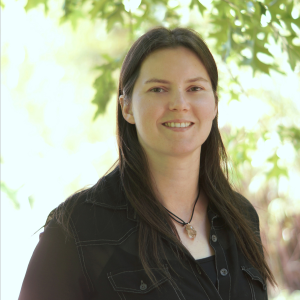
Janin Riedelsberger
I studied Biology at the University of Potsdam in Germany and obtained my PhD from the same university in cooperation with the Max Planck Institute in Golm, Germany. My research interests include ion channels and biological membrane transporters, focusing on the connection between their structure and function. I joined the University of Talca as a postdoc in 2014. Currently, I am teaching various courses related to Biotechnology and Genomics, and I am actively involved in the PhD program of Modelling of Chemical and Biological Systems. My research group joins research assistants, post- and undergraduate students from different backgrounds, which enriches the multidisciplinary character of the group.
Research Lines:
- Transport systems in biological membranes
- Structure and function relation of plant ion channels and ion transporters
- Combination of experimental (molecular biology and electrophysiology among others) and computational (homology modelling, molecular dynamics simulation, ABF) approaches
Recent Publications:
ORCID: https://orcid.org/my-orcid?orcid=0000-0002-4687-7495
ResearchGate: https://www.researchgate.net/profile/Janin-Riedelsberger?ev=prf_overview
Recent Funding
Fondecyt Regular (#1240167), “Identification and characterization of external substrate binding sites in plant sugar/H+ symporters by deciphering the sugar specificity of plant apple and pear STP13 transporters”, 2024-2028, Principle Investigator
Internal grant from the University of Talca for “Promotion and strengthening of research, development, creation and innovation led by women academics”, “Comprobando el estado de oligomerización de la proteína OsHKT de Oryza sativa”, 2023-2024, Principle Investigator
Fondecyt Iniciación en Investigación (#1190767), “Investigation of the pH sensor of the plant sucrose/H symporter StSUT1 from Solanum tuberosum”, 2019-2022, Principle Investigator
Convocatoria Nacional Subvención A La Instalación En La Academia, (#PAI77170035), “Elucidación del mecanismo de conducción iónica de los canales K+/Na+ HKT de plantas mediante estudios computacionales y experimentales”, 2017-2020 , Principle Investigator
Fondecyt Postdoctorado (#3150173), “Investigation of the selectivity and ion conduction mechanism of HKT Na+/K+ transporters”, 2014-2017, Principle Investigator
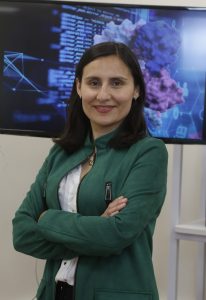
Ariela Vergara
Dr. Ariela Vergara Jaque is an Associate Professor at the Universidad de Talca. She earned her Bachelor’s degree in Bioinformatics Engineering in 2009, followed by a Ph.D. in Applied Sciences in 2013. After completing her doctorate, she conducted postdoctoral research at the National Institutes of Health and Kansas State University in the United States. In 2017, she became a group leader at the Center for Bioinformatics, Simulation, and Modeling. Currently, she serves as the Director of Innovation and Technological Transfer at the Universidad de Talca, where she leads strategic initiatives that foster research, development, and innovation.
Dr. Vergara’s research group specializes in computational approaches to study biomolecular systems, with a particular focus on membrane proteins, which play essential roles in numerous cellular processes and represent critical targets for therapeutic intervention. The group employs advanced techniques in bioinformatics, molecular modeling, and molecular dynamics simulations to investigate biomolecular interactions, such as protein-ligand and protein-protein interactions, supporting the design of drug-like molecules that target specific molecular pathways. Dr. Vergara’s research provides valuable insights into protein behavior under various hypothetical scenarios, working in close collaboration with experimental groups to validate and refine computational predictions.
Dr. Vergara’s contributions to computational biology have been recognized with the L’Oréal-UNESCO Award for Women in Science (Chile, 2013) and the International Rising Talent Award by L’Oréal-UNESCO (France, 2015). In 2025, she was also selected for Santander W50 Chile, an internationally renowned leadership program for women leaders
Research Projects
Projects Led by Dr. Vergara as Principal Investigator
FONDECYT Regular (2022-2026). The identification of protein networks has become an important tool in the treatment channel-associated diseases. Proteomics methods have identified a pool of protein-protein interactions (PPIs) that modulate the Transient Receptor Potential (TRP) channel family. This project aims to determine the structural and functional characterization of TRP:14-3-3 complexes to identify druggable target regions. 14-3-3 proteins constitute an evolutionarily conserved family of small proteins implicated in a wide variety of intracellular signaling pathways by formation of protein–protein complexes. The research proposes to characterize TRP:14-3-3 interactions with therapeutic potential and design therapies based on chemical compounds and peptide formulations to inhibit these molecular associations. This study will help to better understand the key role of 14-3-3 proteins in regulating the expression and trafficking of TRP channels, which can aid in the treatment of channelopathies.
FONDECYT Initiation (2017-2021). Membrane transporters play a crucial role in regulating the transport of diverse solutes into and out of cells. They are associated with several neural and endocrine pathological conditions, making their molecular mechanisms of function essential to study. The project was focused on investigating two specific transporters: the Na+-dependent dopamine transporter (DAT) and the Na+/monocarboxylate transporter 1 (SMCT1). The study consisted in understanding the protein-protein interaction between DAT and Gβγ subunits and identifying possible conserved sodium and iodide binding sites between SMCT1 and NIS. Computational tools in structural bioinformatics and molecular dynamics simulation were utilized to provide insights into the structural basis of transporter function. The findings allowed to detect target regions for structure-based drug design.
NVIDIA Academic GPU (2018). Computational methodologies for simulating and visualizing proteins at the atomic scale have significantly advanced our understanding of biological processes. Our group is dedicated to determining the molecular basis of protein-protein interactions through long-timescale molecular dynamics simulations. However, the high computational cost required to track microscopic molecular details in protein-protein interactions has been a limiting factor in our research. To overcome this limitation, NVIDIA generously donated a GeForce Titan Xp graphics card to our group. This powerful hardware has provided us with the necessary computational power to simulate and analyze protein-protein interactions, with the potential to impact structure-based drug discovery.
Projects with Dr. Vergara as Co-Investigator
FONDECYT Postdoctorate (2024-2026). Molecular basis behind channel regulation: structure and dynamics of the TRPM4 and 14-3-3gamma interaction. Dr. Pablo Galaz.
FONDECYT Regular (2022-2026). TRPV3 and Cav3.2 channels interaction modulates cortical granule release and polyspermy blockade in mammalian eggs. Principal Investigator: Dr. Ingrid Carvacho.
FONDECYT Regular (2021-2025). Computational nanotechnology: rational design of peptide-based functional biomaterials to enhance molecular recognition. Principal Investigator: Dr. Horacio Poblete.
FONDECYT Postdoctorate (2018-2021). Heteroaryl-acrylonitrile derivatives as inhibitors of NADPH Oxidases in an isoform-specific manner. Principal Investigator: Dra. Adriana Treuer.
Millennium Nucleus of Ion Channel-Associated Diseases (MiNICAD) (2017-2020). Millennium Initiative, National Agency for Research and Development (ANID). Director: Dr. Oscar Cerda. The project was renewed in 2020 for three years (https://minicad.cl/).
Outreach
Our group is committed to promoting scientific outreach activities with the community, particularly targeting elementary and middle school students. We aim to inspire young minds and cultivate their interest in science and technology.
- Con holograma interactivo: lanzan primer Laboratorio 5G de la Región del Maule. https://tvdaldia.cl/telecom/con-holograma-interactivo-lanzan-primer-laboratorio-5g-de-la-region-del-maule/
- Podcast B-Woman: Ciencia y Mujer. http://repositorio.umayor.cl/xmlui/handle/sibum/7614
- Historias de Vida: ¿Cómo llegaste a ser académica? https://www.youtube.com/watch?v=8DKqVzpcZxA
- Testimonial UTalca. https://www.youtube.com/watch?v=gNzAwK9Xg4E
- Ingenieras para el mundo – Utalca. “Las proteínas, mi computador y yo” https://www.youtube.com/watch?v=maCKL1OP3Xw&t=428s
- Colegio Santa Elena. Charla Científica ¿Cómo estudiamos las proteínas a través del computador? https://www.youtube.com/watch?v=biw7WeDN_Cg
- Podcast de Realidad Virtual y Bioinformática. Supercomputadoras y Computación Paralela. https://www.youtube.com/watch?v=CGYvTa0bITM
- Explora Coquimbo. Charla Ciencia Abierta: ¿Cómo estudiamos las proteínas a través del computador? https://www.youtube.com/watch?v=Co2JchMiBR0
- American Spaces on Air: La bioinformática y la vida en los EE.UU. https://www.youtube.com/watch?v=5SSYBuBSErk
- Explora en Casa: ¿Cómo estudiamos las proteínas a través del computador? https://www.youtube.com/watch?v=WgVsGCfHaOY&t=1084s
- Charla: Bioinformática y sus aplicaciones a la ciencia. https://www.youtube.com/watch?v=tFrxUTCChPg&t=239s
- Agenda de Género, Radio ADN: Ariela Vergara del Núcleo Milenio Minicad. https://www.iniciativamilenio.cl/agenda-de-genero-ariela-vergara-del-nucleo-milenio-minicad/
- GPS, Radio Cooperativa: La relación entre las mujeres y la ciencia. https://www.cooperativa.cl/noticias/sociedad/ciencia/gps-la-relacion-entre-las-mujeres-y-la-ciencia/2013-10-07/190921.html